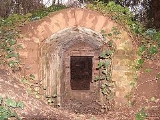
Grendon, Warwickshire
Encyclopedia
Grendon is a Village and Civil Parish in North Warwickshire
it situated three miles (5 km) west of Atherstone
and five miles (8 km) east of Tamworth
.
by a small stream and by the River Anker
.Also, Grendon has since enlarged and is currently at a population of circa 1000.
Grendon is mentioned in the Domesday Book
:
Grendon Hall was demolished in 1933. However, there are several structures of age which remain, most notably the bridge over the River Anker, which in its current form dates back to 1633. The old servants' quarters is now a residential property and several old barns and stable buildings have also been converted into residential properties.
It is rumoured that the houses located on Farm Lane, originally to house farmworkers of Grendon Farm, were built on foundations created from the rubble produced in the demolition of Grendon Hall.
In the woods off Farm Lane can be found a well-preserved underground ice house, which would have been used as a place to store ice (probably dragged from the nearby River Anker during the winter months) to serve the manor house's rudimentary refrigeration needs. This structure is of red brick, with a domed ceiling and is covered by a thin layer of earth. Ice would have been insulated with straw and if the ice was in large enough quantity it would have kept until the following winter.
There are several other mounds of brick and earth in these woods suggesting other structures once existed as well.
Parts of All Saints Church date back to the 12th century, but the tower is a much later addition from 1845. The churchyard has several graves dating back to the 17th century and possibly older, but due to corrosion on some of the graves this is difficult to verify.
North Warwickshire
North Warwickshire is a local government district and borough in Warwickshire, England. The main town in the district is Atherstone where the council is based...
it situated three miles (5 km) west of Atherstone
Atherstone
Atherstone is a town in Warwickshire, England. The town is located near the northernmost tip of Warwickshire, close to the border with Staffordshire and Leicestershire and is the administrative headquarters of the borough of North Warwickshire.-History:...
and five miles (8 km) east of Tamworth
Tamworth
Tamworth is a town and local government district in Staffordshire, England, located north-east of Birmingham city centre and north-west of London. The town takes its name from the River Tame, which flows through the town, as does the River Anker...
.
Old Grendon
The old village of Grendon lies on the north-western tip of Warwickshire, divided from LeicestershireLeicestershire
Leicestershire is a landlocked county in the English Midlands. It takes its name from the heavily populated City of Leicester, traditionally its administrative centre, although the City of Leicester unitary authority is today administered separately from the rest of Leicestershire...
by a small stream and by the River Anker
River Anker
The River Anker is a river in England. The river flows through the centre of Nuneaton towards Tamworth in Staffordshire. The river continues on before merging with the River Tame in Tamworth...
.Also, Grendon has since enlarged and is currently at a population of circa 1000.
Grendon is mentioned in the Domesday Book
Domesday Book
Domesday Book , now held at The National Archives, Kew, Richmond upon Thames in South West London, is the record of the great survey of much of England and parts of Wales completed in 1086...
:
"Henry de FerrersHenry de FerrersHenry de Ferrers was a Norman soldier from a noble family who took part in the conquest of England and is believed to have fought at the Battle of Hastings of 1066 and, in consequence, was rewarded with much land in the subdued nation.His elder brother William fell in the battle. William and Henri...
holds Catmore and five and a half hides in Grendon and Turstin holds of him. There is land for 16 ploughs. There are 24 villans and sixteen bordars with eight ploughs. There is a mill rendering 5 shillings and 36 acres (145,687 m²) of meadow, woodland - one and a half leagues long and one league broad. It was and is worth 40 shillings. Siward Barn held it."
Grendon Hall was demolished in 1933. However, there are several structures of age which remain, most notably the bridge over the River Anker, which in its current form dates back to 1633. The old servants' quarters is now a residential property and several old barns and stable buildings have also been converted into residential properties.
It is rumoured that the houses located on Farm Lane, originally to house farmworkers of Grendon Farm, were built on foundations created from the rubble produced in the demolition of Grendon Hall.
In the woods off Farm Lane can be found a well-preserved underground ice house, which would have been used as a place to store ice (probably dragged from the nearby River Anker during the winter months) to serve the manor house's rudimentary refrigeration needs. This structure is of red brick, with a domed ceiling and is covered by a thin layer of earth. Ice would have been insulated with straw and if the ice was in large enough quantity it would have kept until the following winter.
There are several other mounds of brick and earth in these woods suggesting other structures once existed as well.
Parts of All Saints Church date back to the 12th century, but the tower is a much later addition from 1845. The churchyard has several graves dating back to the 17th century and possibly older, but due to corrosion on some of the graves this is difficult to verify.

